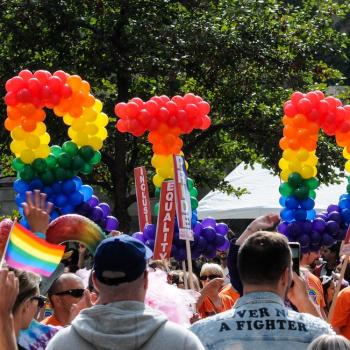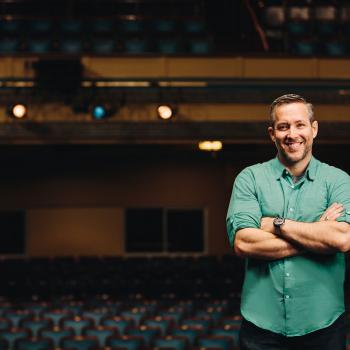 Today’s guest post comes from a friend of mine, Todd Rayburn. Todd is a 2000 graduate of New Orleans Baptist Theological Seminary with a Master of Arts in Marriage and Family Counseling. He’s worked in psych hospitals, clinics, school systems and in private practice. He currently has a private practice in Picayune, MS.
Today’s guest post comes from a friend of mine, Todd Rayburn. Todd is a 2000 graduate of New Orleans Baptist Theological Seminary with a Master of Arts in Marriage and Family Counseling. He’s worked in psych hospitals, clinics, school systems and in private practice. He currently has a private practice in Picayune, MS.
My journey on the issue of homosexuality dates back to my high school and early college years (late ‘80’s). I found myself around an unusually high number of gays and lesbians as many family and friends began to confide in me about their problems. I noticed that as I entered into my early adulthood that gays and lesbians would seek me out and I could not understand why because I am without a doubt heterosexual. I noticed that my “gaydar” (as the homosexual community calls it) was at least as good as any gay person I knew and I could spot a gay person a mile away. All this left me quite confused because I was, am and will always be heterosexual. So I began to pray and ask God why all this was happening. Why were all these people coming to me? Why did I have the ability to just pass some normal looking guy on the street and instantly know he was gay? God began to reveal to me that he was preparing me for the ministry of counseling and that this would be a major issue affecting families. This began my search and my eventual theological understanding of homosexuality.
I often noticed in debates about the subject that the term “homosexuality” was thrown around very loosely and inevitably one side would argue that it was sin and the other would argue the opposite. I finally realized that the term was being use synonymously for both homosexual behavior/lifestyle and homosexual orientation. I noticed that this left audiences confused – thinking the two parties were talking about the same thing when they were in fact talking about two entirely different concepts. Once I realized this, I began to talk to gays and listen to how they described themselves. I also listened to their stories of how they evolved and realized they were different. I listened to how they felt about themselves. It was eye opening to say the least. I began looking at studies on the subject and I combed through all the relevant scriptures. By the time I entered the counseling program at New Orleans Seminary in 1998, I had a pretty good handle on the theology of homosexuality. I discovered that many of my professors had a similar understanding of scripture but no one was talking about it openly. Here we are some 16 years later and now the world is dragging us kicking and screaming into the argument and we are still not educating our people on this subject. We are still more focused on the political than the spiritual. We are still allowing theological ignorance to rule over truth. So what is the truth and what do we know?
Studies tell us that many self identified heterosexuals in the prison system have engaged in homosexual behavior just for human contact and due to a lack of opposite sex partners (Eigenberg, 1992; Sagarin, 1976). These studies also showed that once these people were released, they returned to heterosexual behaviors exclusively. They had been involved in the homosexual lifestyle without having a homosexual orientation. Likewise, many closeted gays and lesbians get married to opposite sex partners and have families before coming out. They have a homosexual orientation but they spend years without engaging in the lifestyle. What is the difference?
Gays and lesbians will tell you that having a homosexual orientation means that when they think about sex or have sexual urges, these urges are directed toward the same sex. They always say that they didn’t ask for these urges. They don’t want them. They want to ignore them and make them go away but just can’t ‘will’ it to happen. The urges are invasive and overwhelming. Does that sound familiar? It should because we all have that same experience. Only for us heterosexuals, it’s for someone of the opposite sex. Their orientation is not now, nor will it ever be a matter of choice. Of all the gays and lesbians I know (and I know a lot), I have never met anyone who chose to have a homosexual orientation.
Homosexual orientation is not sin nor are gay people in sin by having a homosexual orientation. Scripture is clear on the matter that homosexual acts are sin. It is the lifestyle that is the sin. Every scripture you can find on the subject that condemns homosexuality is condemning the acts. So what does scripture say about the orientation?
James 1:14 clearly outlines the progression of sin. Sinful or evil desires (Strongs -1939, epiqumia) “drag us out” to temptation. Temptation leads to sin and sin to death. We all understand that sinful and evil desires are not sin but distortions of the good, God given desires we have. For example, the desire to eat and maintain our body become a desire to glutten ourselves. The desire to talk to one another and build community becomes backbiting and quarrels. I could go on but you get the point. While these desires are called sinful they are in fact not sin but precursors to temptation. They are the reasons we are all tempted in our own unique ways and struggle with the same sin our entire life. God given desires can get distorted by our own sin, sin imposed on us by others or even just the general fall of man. Often times, we don’t know why we have a distorted desire problem. We just do. While I have a number of theories about homosexual orientation, no one but God really knows why it exists and what factors cause it to develop.
Romans 1:24, 26-28 give us our only real look at homosexual orientation. To summarize, God had put his hedge of protection around a people to protect them from themselves. That’s no big surprise because that is a habit of His. He develops a relationship with them (they “knew” God) but it was not a salvation knowledge of God. God offered Himself to these people and they reject Him in favor of other “gods.” The Bible then says He “gave them over” (Strongs – 3860, paradidwmi) to the sinful desires of their heart. He did not force it upon them. He gave them over to the same sinful desires described in James 1. It did not say He put those desires in their hearts because after all, James 1:13 tells us that God does not tempt. He simply took his hedge of protection from them because they made it clear they did not want Him. He gave them over to the desires that were already in their hearts. How did they get there? Again, I don’t know and quite frankly, it doesn’t really mater. What matters is what will each of us do with the gospel and if saved, will we choose to honor God regardless of how we feel and what sinful desires well up within us? Romans 1 was about homosexual orientation but it could have just as easily been about any other sin (false witness, murder, covetousness, adultery). The bottom line is that homosexual orientation is a desire issue that leads to temptation. It is not sin. At the point of temptation, we have a choice to reject the urge or embrace it and sin. We do not have the choice of what desire problems we face. If a heterosexual man sees an attractive woman and is unwillingly confronted with a sexual thought, is that sin or temptation? It is temptation. If he rejects the thought, he does not sin. If he embraces the thought in his heart and acts on the temptation either physically or mentally, he sins. So it is with homosexually oriented people.
So then how should we act and what should we do? Love people and be honest. Part of winning people to Christ is to give them the whole truth. Just as Paul prayed for his “thorn in the flesh” to be taken from him and it never was, so we have our own thorns in the flesh that never leave us. Most (99.9999%) homosexuals will never see their orientation change regardless of their salvation. For them to be saved means a life of constant sexual urge management and for most, celibacy. There are those that can have heterosexual urges as they seek God and grow closer to Him. But in times of stress and times of spiritual valley, the homosexual urges come back with a vengeance. They also need to know what scripture says about their orientation and behavior. The homosexual community respects this honesty. In this way, we CAN stand for what is right and moral in scripture while still fulfilling the Great Commission in the gay community. They may or may not embrace Christ but at least it opens the door to sharing the gospel rather than our rhetoric closing their hearts before we get to the gospel presentation. If we communicate the gospel and a sound theological argument regarding homosexual orientation and lifestyle, we will still have to make that decision Dr. Mohler spoke of, but we can do it with the compassion and love Josh spoke of – no compromises.
Additional Scriptures: Rom. 7:18-25, 8:1-17, 9:19-21; James 1:21; 1 Cor. 6:9-11, 10:13; 2 Tim. 4:2-5; 2 Pet. 1:3-9, 2:6-22; Gen. 3:6; Matt. 12:34; Mark 7:20-22; 1 John 2:17, 5:4-5; 1 Pet. 1:14; Psalm 103:5; Eph. 2:3, Jude 18-19, Jer. 17:10.
Eigenberg, H. (1992). Homosexuality in male prisons: Demonstrating the need for a social constructionist
approach. Criminal Justice Review, 17(2), 219-234.
Sagarin, E. (1976). Prison homosexuality and its effect on post-prison sexual behavior. Psychiatry,
39, 245-257.















